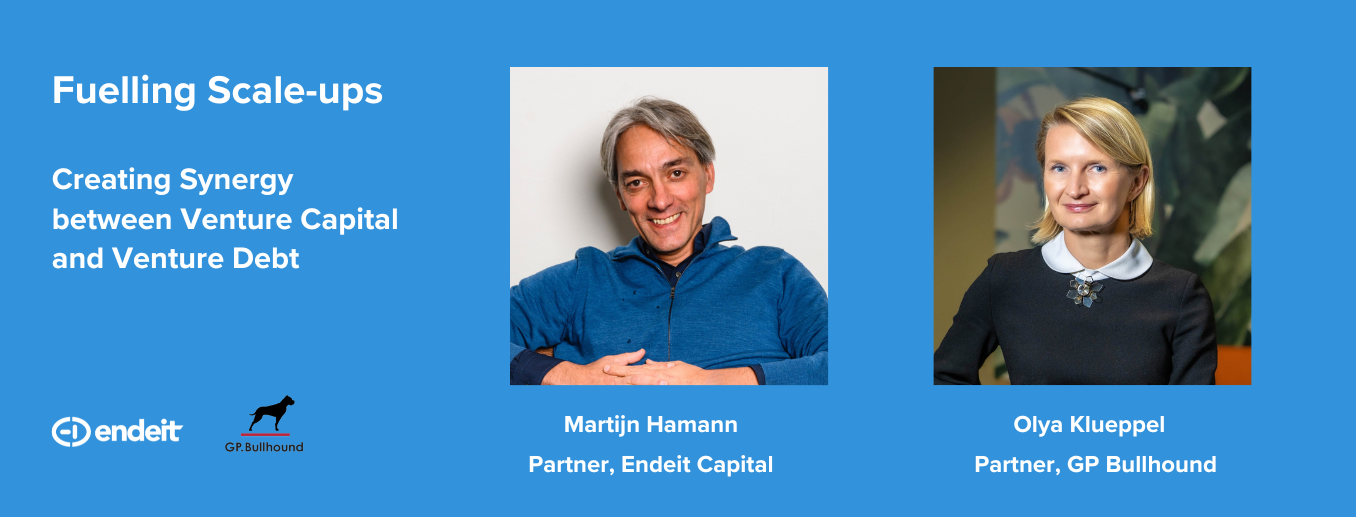"VCs and Entrepreneurs like risks to enable maximum market impact. Equity VC funding together with Venture Debt can further boost, assess, and manage these risks to optimize capital returns."
Fuelling scale-ups: creating synergy between Venture Capital and Venture Debt

Insights from Endeit Capital and GP Bullhound
In a rapidly evolving market landscape, venture debt has become a powerful financing tool for start-ups and early-stage companies. In this blog post, we provide an overview of when and how venture debt can be leveraged with equity funding to drive strategic initiatives in both up and down-market cycles.
But before we start, let’s dive into the concept of Venture Debt.
Venture Debt
Venture debt is a structured credit solution designed for high-growth, VC-backed companies, typically with a specific business activity to be funded. It involves covenants, repayments, interest terms, and other features to compensate lenders for the risks. On the other hand, equity is long-term capital that does not require contractual repayment, is flexible towards funding various business activities, and involves selling a portion of the shares in your company in exchange for investment.
We mainly see venture debt loans in the technology sector. By combining venture debt with equity funding, companies can strike a balance between securing the necessary capital and maintaining control over their businesses. Venture debt is primarily offered to companies that have received venture capital funding, typically from Series B onwards. These companies often have high growth potential but may not yet be profitable.
In which situations can venture debt be beneficial for scale-ups?
In general, venture debt has the following key benefits:
1. To bridge to, or combine with, a new equity round > extend Cash Runway
2. To invest on growth > accelerating sales & marketing, M&A
3. Accelerate value creation towards the next equity round or Exit
Extending Cash Runway
One of the primary advantages of venture debt is its ability to extend the cash runway: additional capital to fund operations and assets for longer. This is particularly useful when the exit window shifts, as we see today’s uncertain economic and political times. In a market where cash is scarce, this can be especially advantageous for scale-ups that encounter unforeseen delays or changes in their exit or fundraising plans, including declining valuations.
Investing in Growth
Venture debt can bring additional capital to fund growth and keep strong sales momentum while avoiding a time-consuming equity raise process. Venture debt can relatively easily be deployed and requires comparably lighter due diligence.
Accelerate value creation
By combining debt and equity financing, scale-ups can increase cash flow certainty and invest in larger (for example, M&A) opportunities. Venture debt offers flexibility for companies adapting to market shifts and economic uncertainties, particularly those adjusting strategies to stay competitive. It complements equity funding well, aiding in initiatives that bolster business resilience and long-term value creation. Generally, venture debt lenders can contribute additional capital of around 25-33% of a new equity round with limited dilution, hence creating additional shareholder value.
Choosing the right funding: venture debt vs. equity capital
The choice for high-risk entrepreneurs in early stages: Equity
Equity capital is particularly well-suited for early-stage technology companies developing their proof of concept and market validation. This phase can be highly volatile and unpredictable regarding cash flow as the product’s value to clients is being validated. Therefore, equity financing is most suitable for high-risk entrepreneurial scaling the company until such validation, when future cash flows can be reasonably forecasted.
The choice for stable growth companies: equity + venture debt
Venture debt typically comes into play during later stages: the company has demonstrated its ability to sell and scale efficiently, with a credible path to profitability without relying only on equity cash injections. Therefore, venture debt may not be the most suitable option for companies facing cash shortages. When a company is already struggling with liquidity issues, additional debt could worsen its financial challenges and strain its resources. If a company has difficulty attracting equity investors, it might indicate underlying concerns about its viability or growth potential. Instead, venture debt should be viewed as a complementary financing tool to equity.
How do you choose a suitable debt provider?
When choosing a debt provider, there is no one-size-fits-all solution. Different businesses have different needs, so it is important to consider various factors. Here are some key points to consider:
Investment horizon: Venture debt is designed to align with the investment horizon of VC funds. Venture debt is usually 3 – 4 years, combined with the typical 4 – 7 years VC horizon. Traditional bank debt may have longer loan terms but usually has very limited amounts available for non-profitable companies.
Lump Sum Withdrawal and Amortization: In Venture debt, the loan amount is typically drawn upfront fully (one time), with repayment or amortizations, beginning after a certain period (usually 6 or 12 months). Companies have full visibility on the repayment profile and can plan cash accordingly.
Interest: Interest is paid monthly or quarterly and is normally priced at a spread of 10-12% versus a base rate (Euribor).
Warrants and Fees: Venture debt providers may require warrants, giving them the option to receive shares in the company in the future or the right to participate in the next equity round. A typical warrant arrangement is 10 to 12% of the nominal loan amount and is issued into equity capital at the last funding round’s valuation. For example, if there is €5m venture debt, there may be warrants on top worth €500k (10%) to be issued in shares in the future at a particular valuation. Further, typical venture debt fees include a 1 – 1.5% transaction fee, a commitment fee (€25-50k), and a final repayment fee (0.25 – 0.75%). It adds up, so it is important to calculate the all-in cost (IRR) and review all direct/indirect costs (or dilutive elements) of capital related to the venture debt facility.
Security: Venture debt providers often secure loans with the company’s assets, such as intellectual property or inventory. Venture loan terms also often exclude obtaining debt from other lenders to maintain priority in securing assets (see also Seniority Ranks).
Covenants: This differs a lot per lender, from none to having various covenants related to Cash, EBITDA, and Revenue milestones. Expect financial reporting to require copies of Board materials or even an observer seat. However, there is quite some flexibility here to negotiate, depending on the loan size.
Compatibility and Seniority Ranks: Venture debt financing may not allow other lenders, which is important to consider. Also, how venture lenders fit into the overall capital structure, e.g., in terms of reporting and legal documentation, will require negotiation with debt providers as this may increase reporting workloads.
What do Venture Debt providers look for in tech scale-ups?
Profitability Profile & Strategy: Lenders understand that tech scale-ups often invest heavily in growth to reach their strategic goals, affecting short-term profitability. They evaluate the potential profitability of these growth initiatives and the company’s clear roadmap to cash flow break-even.
Financial KPIs: Metrics such as revenue growth, gross margins, burn rate, and unit profitability are scrutinized. Additional metrics like CAC, CLTV, and NRR are evaluated to gauge the company’s scalability and long-term sustainability.
Debt-to-Income & Equity Ratio: The proportion of venture debt in relation to the company’s revenue and equity invested is assessed. Lenders seek an appropriate loan-to-income ratio aligned with the company’s future cash flow projections and may include this in financial covenants.
CFO Expertise: The ability of the CFO to manage complex debt and equity financing arrangements is considered invaluable. The CFO should have a comprehensive understanding of the financial implications of borrowing and should align the financing strategy with the company’s long-term objectives.
"Debt financing, and venture debt in particular, can be an extremely useful tool for enhancing a company's growth trajectory, particularly in a difficult fundraising environment. However, picking a suitable lender who not only understands the business metrics but also shares the growth outlook with the founders and the board and can navigate market uncertainty is key. A successful financing is based on such alignment of interest to take the company forward."
Thoughts from Olya Klueppel (GP Bullhound) & Martijn Hamann (Endeit Capital)
If you consider venture debt as a complement to your equity financing, here is a summary of some of the key issues that can be critical to a successful venture debt business partnership in combination with VC financing that CEOs should consider:
Consider qualitative metrics alongside financial indicators. When evaluating venture debt term sheets, look beyond just financial numbers. Make sure you examine the availability of future tranches, which allow for staged disbursement of funds, and whether other financing (equity/bank debt) options can be used in addition to venture debt. Consider qualitative factors such as the lender’s industry expertise, reputation, and track record in supporting scale-ups. Assess their understanding of your business model and growth potential. Ask for references and speak with other CEOs/CFOs who dealt with the lender in ‘good & bad’ times.
Have a clear growth plan and financial oversight. Present a well-defined growth plan for your business, demonstrating a clear path to profitability. What is of high significance is to be able to show a deep understanding of your future cash flows and how the venture debt financing will support your growth initiatives. Highlight proof points of customer stickiness and retention to showcase the long-term viability of your business.
Ensure alignment between your management and, in particular, the CFO, core shareholder base (VCs), and lender. Collaborate closely with your CFO to navigate the venture debt financing process. Your CFO should have a strong rapport with the existing shareholders and lenders to trust them with due diligence and negotiation process. Open and transparent communication between your team, board, and the lender is crucial for a successful partnership.

